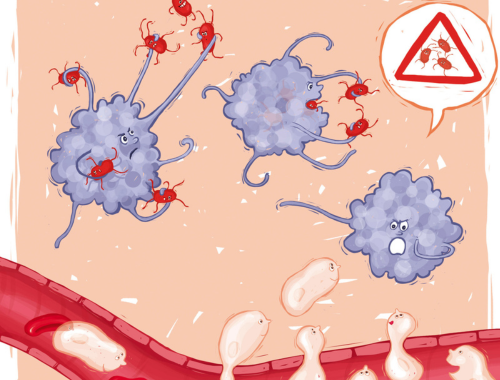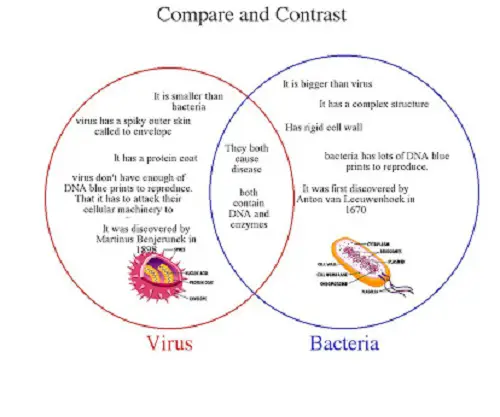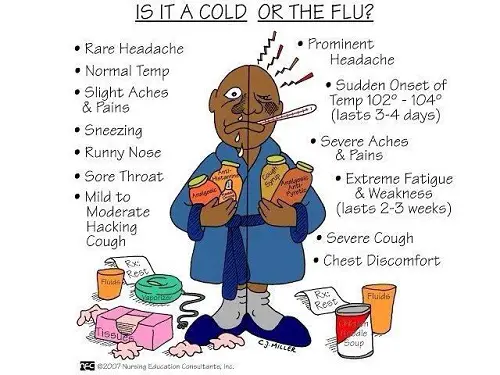Bacteria and viruses are the two major types of microbes and the leading causes of infections among humans. Microbes are small organisms that are invisible to the naked eye. Viruses are the smallest of the microbes that can attack almost any living organism and they typically use another living organism as a host. Viruses are abundant throughout nature. Bacteria are typically much larger in size and they live almost anywhere. Viral and bacterial infections have so many things in common, for example, they can cause mild to moderate and severe infections. So, how do you know which type of infection you have – viral or bacterial? In this article, we look at some similarities between viral and bacterial infections.

What is a viral infection?
Infections caused by viruses are referred to as viral infections. Viruses are infectious agents that are very small in size and can multiply in the living cells of plants, animals or bacteria. Viruses need a living host meaning they cannot reproduce and carry on metabolic processes without a host cell. All true viruses contain nucleic acid – either DNA or RNA – and protein. The nucleic acid is the true infectious part of any virus. Viruses cause common viral illnesses such as flu, common cold and warts.
Viral infections can be mild to severe and can affect different parts of the body, including the digestive system, nervous system and the respiratory system. Respiratory infections are a major cause of morbidity and mortality in humans globally, and most acute respiratory illnesses are caused by viruses. Upper respiratory tract infections such as the common cold are quite common in infants, young children and adults. Lower respiratory tracts infections such as bronchitis and pneumonia occur less frequently.

What is a bacterial infection?
Bacterial infections are caused by small, single cell organisms called bacteria. Bacteria live in enormous numbers in almost any environment on the surface of the earth. As a group, bacteria exhibit diverse metabolic capabilities and can use almost any organic compound, and some inorganic compounds, as a food source. Bacterial infections are diseases caused by bacteria that invade and multiply in the body, causing inflammation and tissue damage. Common examples of bacterial infections include urinary tract infections (UTI), pneumonia, and food poisoning.
Bacteria are characterized morphologically by the absence of a membrane-bound nucleus and therefore ranked among the unicellular life forms called prokaryotes. Some bacteria may release toxins that can travel through the blood and can cause life-threatening illnesses. Others may directly degrade your tissues or trigger aggressive cascades within the immune system. The degree of severity depends on several factors, such as:
- the affected tissue or organ
- the strain of bacteria and inoculums size
- the status of host
Similarities between Viral and Bacterial Infections
Symptoms
– Although bacteria and viruses have long been used for research purposes to create life-saving medicines, both can be equally life threatening. Viral and bacterial infections have so many things in common, for example, they can cause mild to moderate and severe infections, and can exhibit similar symptoms, such as cough and cold, fever, vomiting, inflammation, diarrhea and fatigue. They can also cause the same diseases, such meningitis, diarrhea, and pneumonia.
Transmission
– Both viral and bacterial infections are contagious and can be transmitted from one person to another in many of the similar ways, such as close contact with the infected person, contact with the body fluids of that person, and so on. They can also be transmitted through the air, such as through coughing or sneezing. Bacteria often interact with viruses either directly or indirectly through a specific bacterium that aids viral infection.
Treatment
– Unlike bacteria, virus requires a living host to survive and can only reproduce by piggybacking to cells. While both bacteria and viruses are different types of microorganisms, infections caused by them can be treated with medications. Antibiotics can be used to treat bacterial infections and antiviral drugs can be used against viral infections. The key is to differentiate between a viral infection and a bacterial infection.
Prevention
– Both viral and bacterial infections can be prevented by practicing proper hygiene, such as washing your hands regularly, avoiding close contact with infected people, cleaning and disinfecting objects you use more often, avoiding touching your eyes, mouth and nose, etc. Vaccines are also available for some viral and bacterial infections, which can aid in the prevention of disease spread.
FAQs
What are the similarities and differences in bacterial infections and viral infections?
Viral and bacterial infections can exhibit similar symptoms, such as cough and cold, fever, vomiting, inflammation, diarrhea and fatigue. However, bacterial infections are caused by small, single cell organisms called bacteria whereas viral infections are caused by viruses which require a host cell to survive.
What are the similarities and differences between viruses and bacteria?
Both viruses and bacteria are microbes and almost invisible to the naked eye, and both lack membrane-bound organelles. However, viruses require a living host to reproduce and carry on metabolic processes whereas bacteria are single-cell organisms that can reproduce independently
Is a virus alive why or why not?
Some scientists argue that viruses are not truly alive because they rely on host cells, while others argue that viruses are a distinct form of life. But, viruses cannot survive without on their own; they need a living host to reproduce.
What are similarities between viruses and organisms?
Both viruses and organisms have genetic material, which can be either DNA or RNA and both possess the ability to evolve and adapt to the environment.
What are 2 similarities between viruses and cells?
Both viruses and cells can:
1. Contain genetic material, which can be either DNA or RNA, and
2. Utilize genetic information to create proteins.
What are some similarities and differences between a cell and a virus?
Cells are living organisms with a membrane-bound nucleus whereas viruses need a living host to carry out metabolic processes.
What are 3 differences between bacteria and viruses?
- Bacteria are living organisms whereas viruses are not.
- Bacteria are usually larger in size than viruses and are typically more complex.
- Bacteria can survive on their own whereas a virus requires a living host to survive.
What are 5 differences between viruses and bacteria?
- Viruses do not have a cell membrane, while bacteria do.
- Antibiotics can be used to treat bacteria, while antiviral drugs are required for viruses.
- Viruses are typically harmful and can cause mild to severe infections, while bacteria may or may not be harmful.
- Bacteria can reproduce on their own, while viruses require a host cell to reproduce.
- Unlike viruses, bacteria can perform metabolic functions on their own.












Leave a Reply